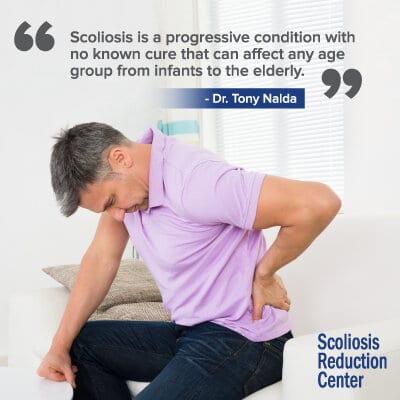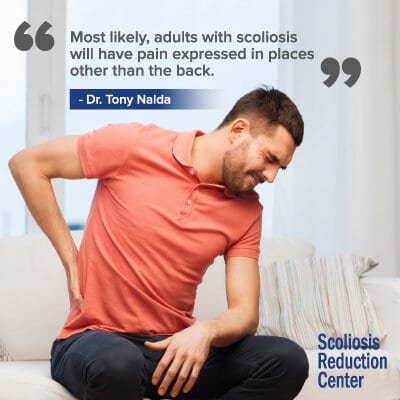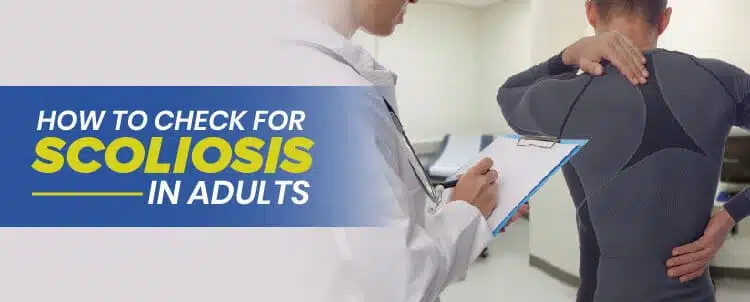Although scoliosis is more common in adolescents, adults can develop the condition as well. In many cases, adults with scoliosis first developed it during adolescence but continued aging with the condition undiagnosed. Regardless of when the condition first developed, the main ways to check for scoliosis in adults involve monitoring postural changes and X-rays.
Age Groups Affected by Scoliosis
When scoliosis is found in young children who have not yet reached adolescence, this type is called pediatric scoliosis; infant scoliosis falls under that umbrella.
Scoliosis and Infants
- Scoliosis rarely develops in infants, but when it does appear in infants under the age of two, it is referred to as infantile idiopathic scoliosis. Just like the majority of scoliosis cases, the cause of infantile idiopathic scoliosis is unknown.
- While there is data showing that many infantile idiopathic scoliosis cases with small curves can resolve on their own over time, there is no way of knowing which condition will progress and which will improve. Consistent monitoring is recommended until it is determined whether or not the curve will progress with growth and time.
 Scoliosis is a progressive condition with no known cure that can affect any age group from infants to the elderly.
Scoliosis is a progressive condition with no known cure that can affect any age group from infants to the elderly.
Juvenile Early-Onset Scoliosis
- Juvenile early-onset scoliosis occurs in children between the ages of three and ten.
- While infantile, adolescent, and juvenile early-onset scoliosis all technically fall under the Pediatric Scoliosis umbrella, juvenile early-onset has a key difference; if left untreated, juvenile early-onset scoliosis is most likely to progress during childhood and well into adulthood.
- This is because in most cases of juvenile early-onset scoliosis, the individual has not yet gone through their adolescent growth spurt so they are at a high risk for rapid and continued progression.
Scoliosis and Adolescents
- Adolescent Scoliosis represents the largest group of known diagnosed scoliosis cases. Adolescents between the ages of 10 and 18 represent the age group that scoliosis is most common in.
- For adolescent scoliosis, the condition’s progression is connected to growth. The more growth spurts an adolescent experiences, the more likely their condition is to progress. In adolescent scoliosis, monitoring growth and progression patterns is an important component of treatment.
Growth and Progression
As mentioned earlier, the number-one known cause of progression is growth. Individuals with the most growth to go through are at the highest risk of progression. As scoliosis tends to worsen during times of growth, it can affect young people who have not yet reached the peak of their adolescent growth spurt more than anyone else.
Skeletal Maturity and the Risser Sign
Fortunately, when it comes to monitoring potential growth, there is an indicator that is visible on X-rays, and this can help determine how much more growth an individual has yet to go through.
The Risser Sign refers to the level of pelvic calcification as an indicator of skeletal maturity. This information can be very useful in predicting how much more a child will grow. Measured on a scale of zero to five, five indicates adult skeletal maturity levels. Generally speaking, the higher an individual’s Risser score, the less likely it is that their curve will progress.
Scoliosis and Adults
- While it can be hard to imagine not noticing an abnormal spinal curvature in a juvenile or adolescent, many cases of early-onset juvenile scoliosis and adolescent scoliosis go undiagnosed; those individuals then enter into adulthood with the condition, most likely having progressed significantly throughout the puberty stage.
- If curvatures are left to progress unimpeded during growth spurts, the risk is that the condition progresses significantly as no preventative treatment has been started.
- While it is never too late to start treatment, the greatest levels of successful treatment are those that are implemented as close to the time of diagnosis as possible. One of the main reasons an adolescent might go through the teenage years without a diagnosis and wind up an adult with the condition is due to an absence of noticeable symptoms.
Scoliosis and Pain
Many people struggle to understand just how a condition that causes a spinal deformity like scoliosis is so difficult to diagnose. While the condition isn’t exactly hard to diagnose, it’s hard to diagnose early.
While successful treatment often depends on catching a progressive condition early on, with scoliosis, the condition is hard to spot until it has progressed to a certain degree. Once a curvature worsens to the point where postural changes are noticeable to someone other than a scoliosis expert, this is often the time individuals or their caregivers will seek help from a medical professional.
When an individual with scoliosis is growing, there is an absence of pain as the upward growth motion is lengthening the spine. Adults experience scoliosis-related pain very differently as they have stopped growing; in these cases, a curvature causes compression of the spine and its surrounding nerves and tissues. This is why it’s quite common to see an adult with a condition they’ve had throughout adolescence that has just recently become symptomatic.
Keep reading: Dowager’s Hump: What Is It, Symptoms, Diagnosis, & Treatment
Causes of Adult Scoliosis
While the vast majority of adult idiopathic scoliosis cases are extensions of undiagnosed adolescents with the condition, there are some additional known causes. For cases of individuals developing scoliosis in adulthood, natural aging and degenerative processes are thought to contribute to the condition’s development.
Paralytic Curve
A paralytic curve can develop in adulthood when the spine’s surrounding muscles aren’t working properly. Over time, this can throw the spine out of alignment. Paralytic curvatures can develop as a result of spinal cord injuries that precede paralysis.
Neuromuscular Diseases
Neuromuscular diseases such as cerebral palsy, muscular dystrophy, or polio can lead to abnormal spinal curvatures in a myopathic deformity; in this context, a myopathic deformity means muscles aren’t functioning properly.
Osteoporosis
Scoliosis that develops in adulthood can be the result of a secondary condition like osteoporosis. As people age, especially women, they can experience a loss of bone mass; this can lead to compression fractures of the spine and the development of scoliosis.
The degenerative effects of aging can cause scoliosis to develop later in life as the spinal discs and vertebrae wear along with the rest of the body. If a vertebrae slips out of alignment, putting more strain on the discs, this can result in the development of an abnormal spinal curvature.
How to Diagnose Scoliosis in Adults
- When it comes to how an adult reaches a scoliosis diagnosis, the process is similar to how it occurs in other age groups: postural changes and X-ray results. The one big difference in adults is the presence of scoliosis-related pain.
- With adults, the most likely scoliosis symptom they will experience is pain. Because they are no longer growing, a curvature will compress the spine and cause pain and discomfort. Pain is often what brings an adult in to see me.

- Most likely, adults with scoliosis will have pain expressed in places other than the back. Often, pain is experienced in the feet, knees, and hips. This is understood as a result of the body’s asymmetry caused by the curvature.
- Postural changes in adults with scoliosis would include asymmetries of the waste, hips, space between the arms and the body, level of shoulders, head position to the torso, torso position to the pelvis, the characteristic rib-hump, and a noticeable deformity in the back.
- If an adult is experiencing spinal pain or pain in the feet, knees, and hips, they should visit a scoliosis specialist. If pain is paired with any of the aforementioned postural changes, it’s likely that scoliosis is a factor.
- At this point, a specialist will do a visual assessment of the individual’s posture and gait and order an X-ray to determine the patient’s Cobb angle; this is a measurement of how far a curvature bends and twists away from a straight alignment. This measurement places the condition on the mild-to-severe scale.
Conclusion
The vast majority of adult idiopathic scoliosis cases are adolescents that continued to age with their condition undiagnosed. Cases of individuals who develop the condition in adulthood most likely result from neuromuscular disease, the spine’s surrounding muscles not functioning properly, a secondary condition like osteoporosis, or the degenerative effects of aging.
When it comes to how to check for scoliosis in adults, the process is similar to how most cases are first diagnosed: visual assessment and X-rays. Most cases of scoliosis are diagnosed because of noticeable postural changes that cause individuals and their caregivers to realize something wrong is happening within the body. When it comes to adults with scoliosis, it is often pain, as well as postural changes, that brings them in to see me.
Regardless of when or why an adult develops the condition, there is always hope with effective treatment options like the chiropractic-centered approach we offer here at the Scoliosis Reduction Center®.





